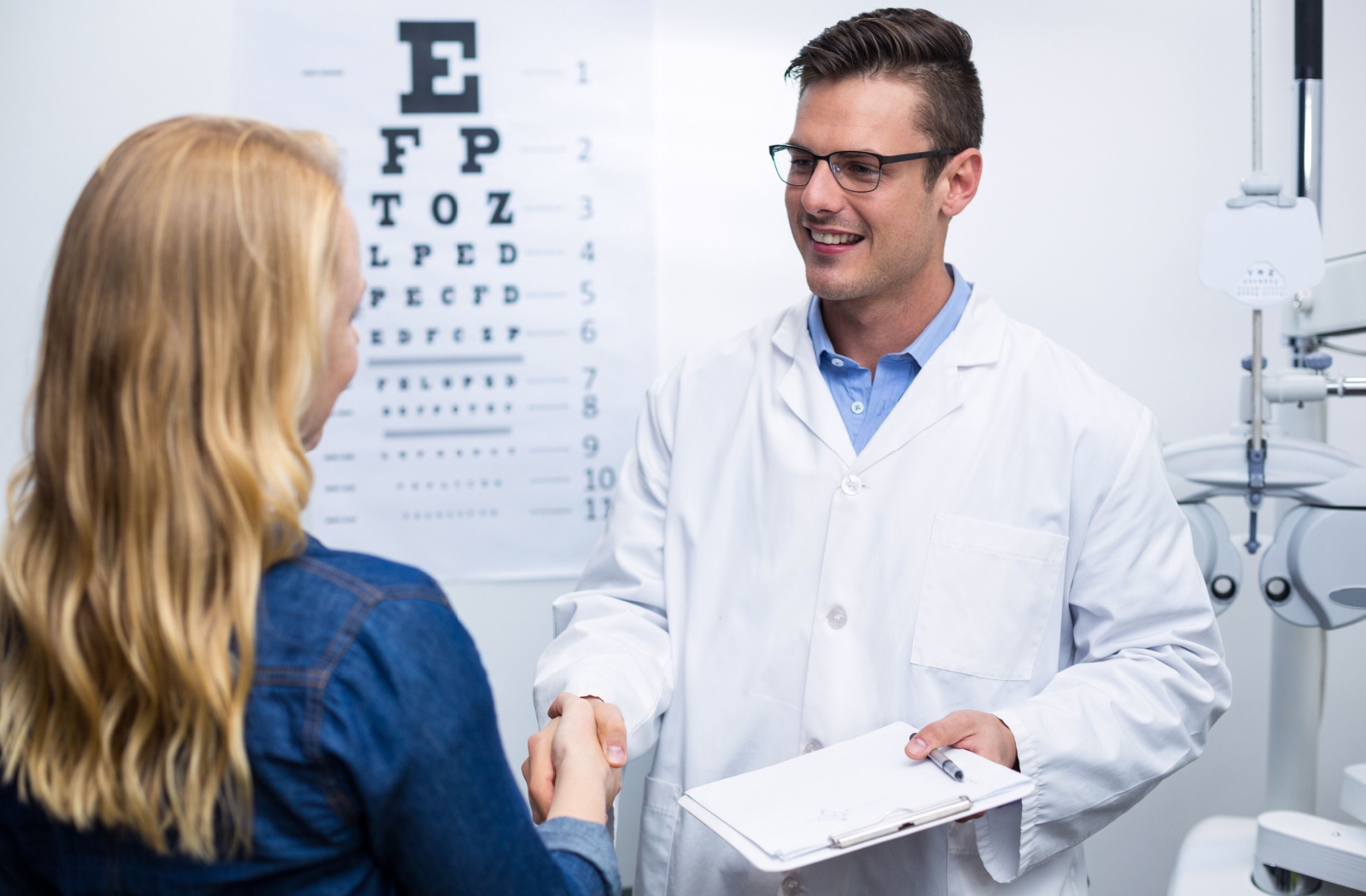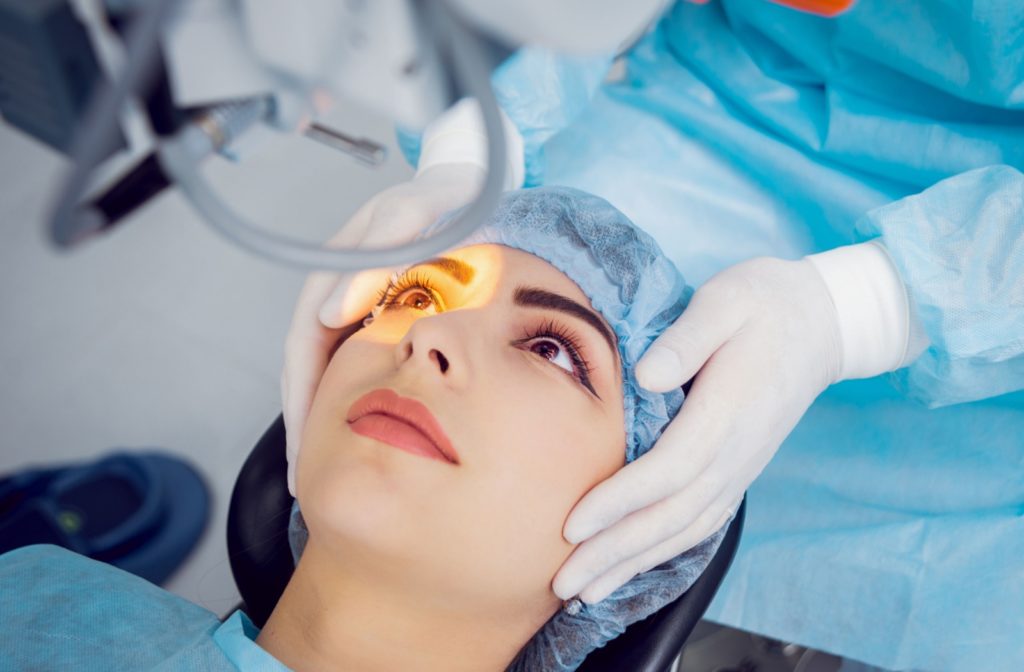If you’ve lived most of your life with contact lenses or eyeglasses, you’ve likely been thinking about a more permanent solution. While glasses and contacts are amazing for vision correction, they can occasionally have drawbacks. Fortunately, for people looking for a long-term answer to their vision problems, there’s an answer: laser eye surgery. But does laser eye surgery hurt?
While you may experience some discomfort during laser eye surgery, it rarely hurts. Your surgeon will apply a numbing agent—likely with eye drops and an oral medication—to prevent any severe discomfort.
How Does the Eye Work?
The human eye is wonderfully complex—and also extremely sensitive. It requires a delicate balance to get light from the outside world to your brain.
At the front of your eye, there’s a natural clear lens. This lens is curved and helps refract light through the rest of your eye to reach a singular focal point on the retina. There, this visual information is sent through the optic nerve to your brain.
You can see refraction of a lens if you’ve ever shone a light through glass, water, or any other clear material: Every time the shape of the material changes, or if you change the angle of the light, it gathers somewhere else. Think of any time you’ve used a magnifying glass; it only focuses clearly at a certain point, and every other point is blurry.
Your eye is similar to this. It requires a specific shape to be able to properly refract light onto the back of the eye. If there’s a problem with the shape of your eye or the curve of your lens—like when you have nearsightedness or farsightedness—the light doesn’t focus where it needs to. This leads to blurry vision.
What is Laser Eye Surgery?
These surgeries involve the precise reshaping of your eye’s natural lens. This helps light enter, and refract, properly throughout the eye. Once the surgery is complete and you’ve recovered, you no longer need to deal with blurry vision every day. Instead, you’ll be able to see clearly without any need for vision correction.
The two most popular types of laser eye surgery are:
- Laser-assisted in Situ Keratomileusis, more commonly called LASIK, and
- Photorefractive Keratectomy, more commonly called PRK
Both of these surgeries involve the use of a high-tech laser handled by an experienced surgeon. LASIK is the more common surgery and is ideal for most people who have a normal-sized cornea and have had a stable prescription for more than 1 year. On the other hand, PRK may be recommended if you have a thin cornea or irregularities in its curvature.
Laser Eye Surgery: A Step-By-Step Guide
When it comes to laser eye surgery, there are three primary steps:
- The consultation
- The procedure
- The recovery
Each of these steps is crucial to the likelihood of a successful surgery.
The Consultation
If you’re thinking about laser eye surgery, it all begins with a consultation. This is where you meet with a specialist to determine if you’re a candidate for the procedure.
While LASIK or PRK are often ideal choices, not everybody is a candidate; a few factors can contribute to whether or not you’ll be recommended for one of these surgeries:
- Your overall eye health. If you have conditions like dry eye or corneal damage, you may not qualify for surgery.
- The thickness, size, and shape of your cornea.
- Your age. These surgeries can’t be performed if you’re under the age of 18 or more, since your eyes are likely still growing.
- Whether or not your prescription is stable.
If your optometrist believes you’re an ideal candidate for surgery, they’ll recommend you to an appropriate laser eye surgeon nearby.
The Procedure
The day of your surgery, you’ll be awake and aware throughout the process, but numbed to any pain. There are a few steps to this process of limiting discomfort. First, your eye will be numbed with specialized drops, and you’ll likely be given an oral medication to help as well. You may be given a sedative to ensure you relax, so you can expect to be wide awake but perfectly at ease.
Then, the next steps depend on the surgery in question.
LASIK
For LASIK:
- A protective flap is created on the surface of the cornea using a precise, computer-guided laser.
- The surgeon then gently lifts this flap to access the underlying corneal tissue.
- A different laser then reshapes the cornea’s surface, correcting the refractive errors that cause nearsightedness, farsightedness, or astigmatism.
- Once the cornea is correctly reshaped, the protective flap is carefully repositioned back over the treated area.
- The flap begins to adhere naturally to the underlying cornea without the need for stitches, effectively sealing itself during the healing process.
PRK
For PRK:
- Instead of creating a flap, the outer layer of the cornea, called the epithelium, is gently removed to expose the underlying corneal tissue.
- Similar to LASIK, a laser then reshapes the cornea based on the individual’s unique prescription, correcting the imperfections in the eye’s focusing power.
- After the cornea is reshaped, a soft contact lens is placed on the eye to act as a bandage. This helps protect the eye while the epithelium regenerates and heals over the reshaped corneal surface.
Both LASIK and PRK are outpatient procedures, meaning you can go home the same day. However, you will need somebody else to drive you home; your vision will be actively recovering for at least a few hours, and it’s not safe to drive in that initial time frame.
The Recovery
The recovery period is as important as the surgery itself. Your eyes may feel scratchy, irritated, or uncomfortable for a few days following the surgery; you should resist the urge to scratch them at all costs. They’re still healing and rebuilding, getting used to this new lens shape.
While recovering, you’ll likely experience the following for a few days:
- Light sensitivity
- Blurred vision
- Mild discomfort or pain
- Dry eyes
This shouldn’t be painful; if you experience any significant pain at any point post-surgery, immediately contact your optometrist. These symptoms will likely go away within a few days to a couple of weeks after the surgery. Your optometrist will have you come back for a follow-up appointment after your surgery to monitor your recovery.
Once you’ve recovered, you’ll be able to see clearly—without needing your old contacts or eyeglasses!

Book Your Laser Eye Surgery Consultation
Laser eye surgery can be a life-changing decision full of benefits. If you’re living with vision issues, contact our team at Tutt Street Optometry Clinic. Our team can perform a consultation appointment to find out if laser eye surgery could be the right choice for you. Book an appointment with us today, and take the first step towards clearer vision!




